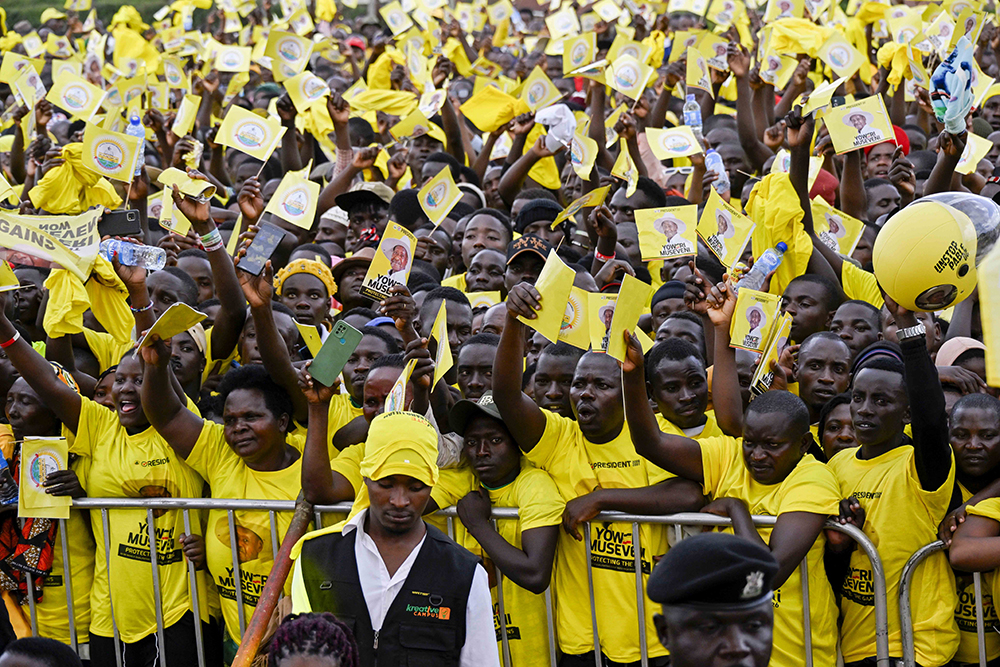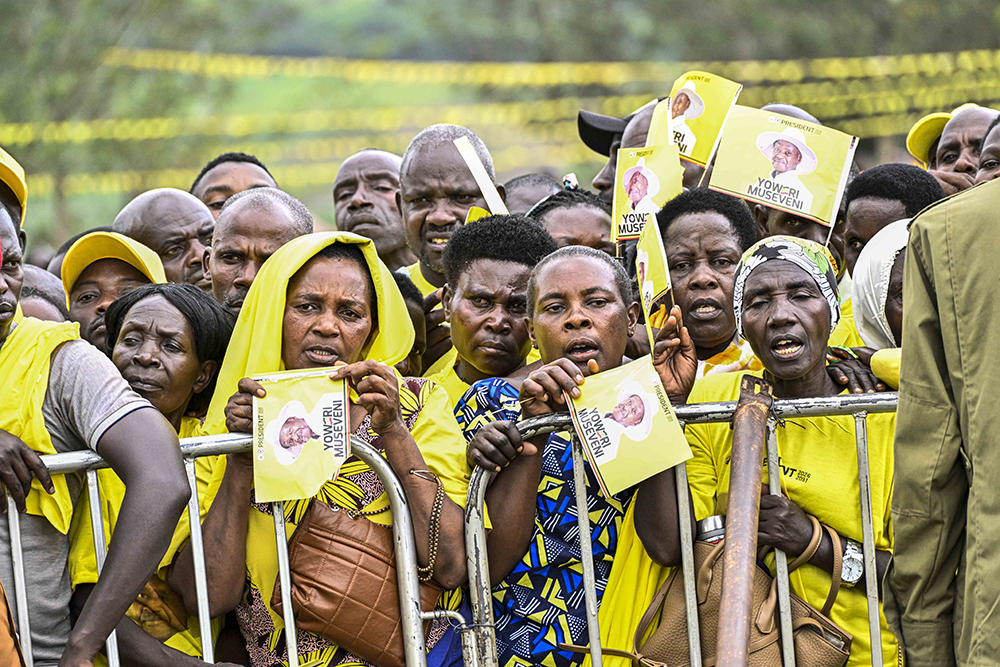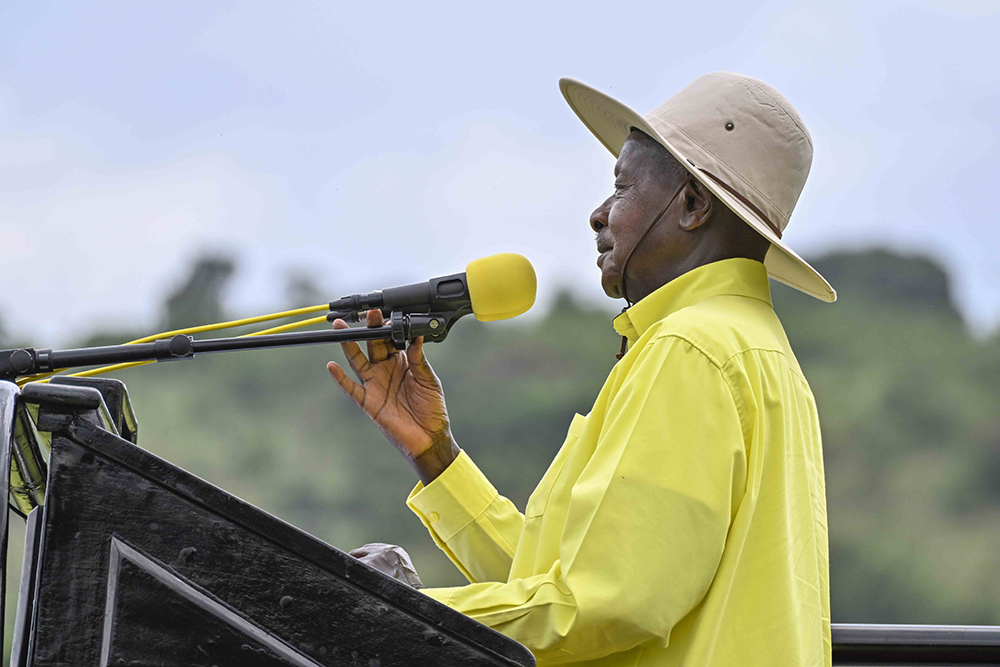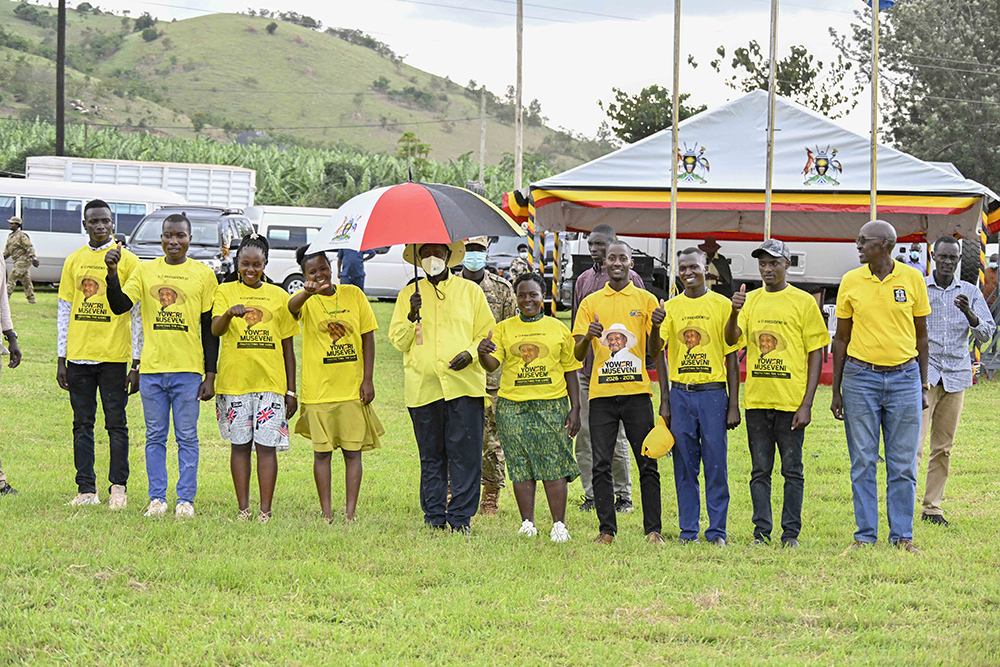Museveni rallies Ankole behind NRM agenda of stability, rural transformation
The rally at Isingiro district headquarters drew thousands of supporters who listened as the President opened his address by reflecting on the contrasting conditions between Uganda’s turbulent past and the relative calm enjoyed today.
President Yoweri Kaguta Museveni welcomed by his supporters in Isingiro district on Thursday (November 27). (PPU photos)
________________
President Yoweri Kaguta Museveni began his campaign trail in the Ankole subregion with a strong appeal for continued peace, upgraded infrastructure and renewed household wealth creation as the NRM’s guiding priorities.
Campaigning in Isingiro district on Thursday (November 27), he said improved roads and restored stability have created the foundation for growth, but warned that many families remain trapped in poverty despite national progress.


The President, who is also the National Resistance Movement (NRM) presidential flag bearer, travelled with his daughter, Patience Rwabwogo Museveni, as they met supporters across the district.
The rally at Isingiro district headquarters drew thousands of supporters who listened as the President opened his address by reflecting on the contrasting conditions between Uganda’s turbulent past and the relative calm enjoyed today.
He began with gratitude, saying, “As I introduce to you the 2026/31 Manifesto, I want to thank God. I came here today wearing yellow and without guns. In the past, 1972, 1979, and 1985, I passed through here with guns, fighting. But today, we have gathered peacefully, well-dressed, dancing, and united. I thank God, and I thank the NRM for restoring peace in Uganda.”
That theme of security as the foundation of national progress ran throughout his speech. He told the crowd that the peace the country experiences today did not come by chance, and he said it remains the bedrock of the NRM’s development agenda.
The President pointed to extensive road works completed in the region, naming the Mbarara to Kikagate to Isingiro road and the Kachumbala to Kabale to Ntungamo road as among the projects already contributing to mobility and trade.
He also outlined the roads that remain priorities, including the Kikagate to Kitwe to Namahimba road and the Kabingo to Rwekubo to Rugaaga to Endizi to Magabi to Rakai to Mutukula road. He said these planned upgrades represent the NRM’s continued commitment to improving rural connectivity and unlocking economic opportunities.
Even as he highlighted infrastructure improvements, the President insisted that development alone does not guarantee prosperity.
He cautioned supporters against conflating national development with household wealth, pointing to Kampala as an example of a place with modern infrastructure but where many residents continue to struggle.
To illustrate this long-standing distinction, he revisited the proposals first introduced in the 1996 Manifesto. During his speech, he reminded the gathering that after securing peace, the NRM proposed the Four Acre Model as a practical strategy for rural families to overcome poverty.


The model allocates one acre for coffee, another for fruits, the third for pasture for dairy cattle, and a fourth for food crops for the home, while promoting backyard poultry or piggery and fish farming for those living near wetlands.
He told supporters that Uganda must embrace wealth creation as a priority, saying the pillars of wealth include commercial agriculture, manufacturing and factories, services such as transport and hospitality, and ICT.
To support families that want to join the money economy, he said the government will continue funding the Parish Development Model and Emyooga programmes, and that additional funds will be introduced for leaders, youth in ghettos, boda boda riders, unemployed graduates, religious leaders and cultural leaders.
He also addressed concerns about employment, saying, “You cannot talk of jobs without talking of wealth. Jobs come from commercial agriculture, factories, services, and ICT.” He contrasted the limited capacity of government employment with the potential of the private sector.
According to him, Uganda has about 480,000 government jobs, a small figure when measured against a population of 50 million. The President said this reality makes it clear that employment cannot depend on public sector vacancies.
To emphasise the point, he cited Mbale Industrial Park, which today hosts more than 75 factories and has generated thousands of jobs. He added that while government employs 480,000 people, new factories nationwide have already created 1.3 million jobs, almost three times as many as the public sector.
In Isingiro, where banana farming dominates the local economy, the President continued his agricultural focus, advising farmers to adopt modern methods and irrigation to expand productivity. He said that improving banana output will strengthen incomes and ensure that Isingiro’s competitive edge in regional markets is maintained.
Towards the end of his address, he presented the NRM flag to the district’s aspiring Members of Parliament, LC V chairpersons, councillors and other party candidates, endorsing their participation in the forthcoming elections.
The Speaker of Parliament and second national vice chairperson of the NRM, Anita Annet Among, also addressed the rally and praised the district’s organisational strength. She encouraged residents to stay committed to the ruling party, saying the district is known for its accountability and efficiency.
She added that earlier in the day, leaders had launched a workers’ SACCO to help boost incomes and strengthen local development. She also thanked the President for the peace and stability that allow refugee-hosting districts like Isingiro to function, noting that water projects such as the Kagera and Doctor Deep systems are improving access to clean water for both host communities and refugees.


“We do not have audit queries in Isingiro, and that speaks to the discipline and transparency in this area,” she said. She added, “This is a refugee-hosting district, and we thank you, Your Excellency, for the peace and stability that allow these communities to thrive. This party is not just for President Museveni; it is for all of us.”
The animal industry state minister Lt Col Bright Rwamirama, expressed confidence that Isingiro would deliver overwhelming support in the coming elections. He thanked the President for his continued support and assured him of the district’s loyalty.
NRM district chairperson Lt Moses Mushabe echoed this sentiment, reminding the President that Isingiro delivered 94 percent of the vote in the 2021 general elections. He said, “This time, the remaining votes will also go to you, Your Excellency.”
Lt Mushabe outlined the district’s population of 635,077 people distributed across 30 sub-counties and town councils, 131 parishes and 901 villages. He noted that the district’s needs are growing quickly, particularly in health care, because it hosts refugees.
Mushabe also presented a detailed overview of the district’s development indicators. Under the Parish Development Model, he said Isingiro has received sh47.1 billion, including funds released in November 2025.
So far, 41,131 households have benefited, representing 27.7 percent of all households. He added that the district has 89 Emyooga SACCOs with 31,901 members and that government financing for these groups totals sh3.35 billion.
On education, Mushabe said Isingiro now has 197 government primary schools and 543 private primary schools. It also has 21 government secondary schools and 75 private secondary schools. However, some areas still lack government institutions.
To address this, the district is constructing seven new Seed Secondary Schools. When completed, the number of sub-counties without government secondary schools will reduce from 16 to 9.
The district’s Presidential Industrial Skilling Hub, based in Mbarara city, has trained 1,226 youth, with 247 others currently enrolled in trades including carpentry, tailoring, metal fabrication, hairdressing, baking and construction.
Mushabe also detailed infrastructure for health and water services. He said that out of Isingiro’s 30 sub-counties, 4 have health centre IVs and 26 have health centre IIIs, leaving 8 sub-counties without a government health facility.
Government plans include upgrading several health centre IIs to health centre III and constructing new facilities in Kabingo and Kagarama. He said water access in the district stands at 51 percent, with 461 of the 901 villages having safe water sources.
Water projects have been a major area of investment. Completed works include piped water systems in Nyarubungo, Rugaga, Kihiihi, Isingiro town council and Kaberere, which collectively serve more than 100,000 residents.
The government has also built 15 protected springs and rehabilitated 41 boreholes. Gravity flow schemes have been expanded, and new boreholes drilled in water-stressed communities such as Kagaga, Karunga, Ntenga, Kyarwanshashura and Kihanda.
Ongoing works include the Isingiro piped water and sanitation system, expansions of the Nyamisindo and Rumuri systems, and new protections for natural springs in Mahaama, Nyakisheshero and Nyakabingo.
Significant investment has also been directed towards water-for-production facilities. These include the Kamwema valley tank with a capacity of 10,000 cubic metres and the Kyakashana tank with 5,000 cubic metres, as well as small-scale irrigation schemes in Ruhimbo, Bugarika and Kibwera.
Major undertakings include rehabilitation of the Kagango dam and construction of large valley tanks such as Nyamarungi. The largest of these projects is the Kabuyanda Multipurpose Dam and Irrigation Scheme, which will cover 3,300 hectares and benefit 32,000 farmers in 38 villages.
According to Mushabe, Isingiro is now fully connected to the national electricity grid, which has boosted businesses, schools, health units and households.